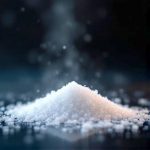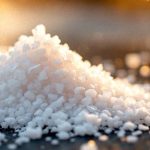Takeaways
- Milk thistle contains silymarin, a powerful antioxidant
- It may protect liver cells from damage and toxins
- Research suggests benefits for various liver conditions
- Milk thistle supports the body’s natural detoxification processes
- Generally safe with few side effects for most people
- Can interact with certain medications, consult a doctor first
What Is Milk Thistle?
Milk thistle is an herb with a long history of use, known scientifically as Silybum marianum.[1] This plant thrives in Mediterranean climates, but now grows in many areas around the globe.
The name ‘milk thistle’ comes from the milky-white liquid that appears when its leaves are crushed.[2] This plant is easily recognized by its purple flowers and the white veins that pattern its large, prickly leaves.[3]
People have utilized milk thistle for over two thousand years, with its use documented in ancient Greece and Rome for addressing liver and gallbladder issues.[4] Even today, it remains a popular choice for supporting liver health and other wellness goals.
Milk thistle is known by various names in different cultures and regions.
- Blessed thistle
- Mary thistle
- Holy thistle
- Variegated thistle
- Scotch thistle
The Active Compound: Silymarin
Silymarin, the primary active ingredient in milk thistle, is a group of flavonoids responsible for the herb’s beneficial properties.[5] This compound is concentrated within the seeds of the milk thistle plant.[6]
To extract silymarin, the milk thistle seeds are crushed and processed.[7] This extraction method isolates the beneficial compounds, resulting in a concentrated form of silymarin for use in supplements.
Silymarin is not a single substance, but a complex of related compounds. These include silybin, silydianin, and silychristin, each potentially contributing different effects within the body.[8]
The key components that make up silymarin include:
| Component | Percentage |
|---|---|
| Silybin | 50-70% |
| Silydianin | 10-20% |
| Silychristin | 10-20% |
| Other flavonoids | 5-10% |
Silybin is often regarded as the most active and potent component of silymarin.[9] It is the focus of the majority of research examining the benefits of milk thistle.
Liver Health Benefits
Protecting Liver Cells
Milk thistle may offer protection to liver cells from damage.[10] This protective effect is attributed to silymarin’s potent antioxidant activity, which helps neutralize harmful free radicals that can cause cellular damage.[11]
Research indicates that silymarin can help reduce inflammation within the liver and may help protect liver cells from toxins, such as alcohol and certain medications, that can be harmful to liver health.[12]
Animal studies have shown promising results, with milk thistle extract demonstrating a protective effect against various liver-damaging substances, including acetaminophen, which can cause liver damage when taken in large doses.[13]
Human studies are ongoing, but initial results suggest milk thistle may benefit people with liver problems.[14] It has shown potential in reducing liver enzyme levels, which can be an indicator of liver damage or disease.[15]
Supporting Liver Function
Milk thistle may contribute to overall liver health. The liver plays a vital role in filtering toxins, producing bile, and processing nutrients, all functions that milk thistle may support.
Some studies suggest that milk thistle can improve liver enzyme levels, potentially indicating improved liver function.[16] Research has investigated its effects on individuals with liver conditions like hepatitis and cirrhosis.[17]
Milk thistle shows potential for individuals with liver conditions, possibly aiding in symptom management and slowing disease progression.[18] However, more research is needed to confirm these effects.
Signs that liver function may be improving can include:
- Lower liver enzyme levels
- Better bile flow
- Reduced inflammation
- Improved detoxification
- Enhanced protein synthesis
Detoxification Support
Milk thistle may support the body’s natural detoxification processes. The liver is a key organ for detoxification, breaking down harmful substances so they can be removed from the body.
Silymarin may enhance the liver’s capacity for detoxification, potentially helping it process toxins more efficiently.[19] This could help reduce the burden on the liver as well as other organs.
The idea of a “liver cleanse” is popular, and milk thistle is often included in these plans. While the body naturally detoxifies itself, milk thistle may provide extra support for this process.
The liver’s detoxification process involves these main steps:
- Toxins enter the liver through the bloodstream
- Phase I enzymes begin breaking down toxins
- Phase II enzymes further process the toxins
- Toxins are made water-soluble for elimination
- The body excretes the processed toxins
Milk thistle may provide support at various stages of the liver’s detoxification process.[20] It could potentially boost enzyme activity and protect liver cells during detoxification.
Other Potential Health Benefits
Milk thistle’s benefits may extend beyond liver health. Research is exploring its potential effects on other body systems, and initial results are encouraging, though more studies are needed.
Some studies suggest that milk thistle might help manage blood sugar levels, which could be helpful for those with diabetes.[21] The herb may improve the body’s sensitivity to insulin and help lower blood sugar levels.[22]
There is also growing interest in milk thistle’s potential benefits for heart health. It may help lower cholesterol levels, and some studies suggest it could reduce the risk of heart disease.[23]
Here is a summary of the potential benefits and current research areas for milk thistle:
| Potential Benefit | Research Status |
|---|---|
| Blood sugar control | Promising early results |
| Cholesterol reduction | Mixed findings, more research needed |
| Cancer prevention | Early stage, inconclusive |
| Skin health | Limited studies, some positive effects |
| Brain function | Emerging research, needs more study |
These potential benefits are still under investigation. While initial results are promising, more human studies are needed to confirm these effects.
How to Take Milk Thistle
Forms and Dosages
Milk thistle is available in several forms, such as capsules, tablets, liquid extracts, and even as whole seeds. Each form has different strengths and specific uses.
Dosages of milk thistle vary based on the form and intended purpose. Most studies use between 200-400 mg of silymarin daily, but some use doses as high as 600 mg per day, divided into multiple doses.[24]
Determining the right dosage depends on factors such as your health, age, and the specific condition being addressed. It is usually best to begin with a lower dose and gradually increase it if needed.
Common forms of milk thistle supplements include:
- Standardized dried extract (tablets or capsules)
- Liquid extract
- Tincture
- Softgels
- Milk thistle tea
- Whole seeds
Timing and Administration
To maximize the benefits of milk thistle, timing is important. Most people take it with meals to help reduce any potential stomach upset.[25]
For improved absorption, some experts suggest taking milk thistle with foods containing fat. The compounds in milk thistle are fat-soluble, meaning they dissolve in fat, which helps the body absorb them better.[26]
If you take other supplements, space them out from your milk thistle dose. Milk thistle might affect how your body processes certain compounds, so it’s best to wait at least two hours between taking milk thistle and other supplements or medications.[27]
Safety and Side Effects
Milk thistle is generally considered safe for most people.[28] It has a long history of use with few reported problems. However, like any supplement, it can cause side effects in some individuals.
The most common side effects of milk thistle are generally mild, often affecting the digestive system. These can include stomach upset, bloating, or diarrhea.[29] Usually, these effects are temporary and resolve on their own.
Some individuals should use milk thistle with extra caution, including pregnant women, those with hormone-sensitive conditions, and people with certain allergies.[30]
Potential side effects to monitor for include:
- Headache
- Nausea
- Skin reactions (rare)
- Changes in bowel habits
- Mild allergic reactions
If you notice any unusual symptoms while taking milk thistle, stop use and consult with a healthcare provider.
Interactions with Medications
Milk thistle can interact with certain medications, so it’s important to talk to your doctor before starting any new supplement regimen.[31]
This herb may influence how the liver processes certain drugs, potentially changing the levels of these drugs in the body.[32] In some instances, this could make medications more or less effective.
Milk thistle may interact with drugs that are metabolized by the liver. This includes many common medications such as statins for cholesterol and certain antipsychotic drugs.[33]
Here is a table showing common medications and their potential interactions with milk thistle:
| Medication Type | Potential Interaction |
|---|---|
| Statins | May increase drug levels |
| Antipsychotics | Could alter drug effectiveness |
| Blood thinners | Might affect blood clotting |
| Diabetes medications | May enhance blood sugar lowering |
| Hepatitis C drugs | Could interfere with treatment |
Always inform your healthcare provider of all supplements you’re taking. This can help prevent harmful interactions and ensure that your treatment plan is safe and effective.
Milk Thistle in Traditional Medicine
Historical Uses
Milk thistle has a long history in traditional medicine. Ancient Greek and Roman doctors used it for liver and gallbladder issues. They also used it to treat snake bites and to protect the liver from alcohol.[34]
In medieval Europe, monks cultivated milk thistle in their gardens, using it to address liver problems and as a general tonic.[35] It was also a popular remedy in traditional German medicine.
Traditional uses of milk thistle often align with modern research. Ancient healers recognized its benefits for liver health, and today science is exploring these same properties.[36]
Cultural Significance
Different cultures have valued milk thistle for centuries. In some traditions, it was considered a sacred plant. The white veins on its leaves were said to represent the milk of the Virgin Mary.[37]
In folk medicine, milk thistle was used for more than just liver health. Some cultures used it to stimulate milk production in nursing mothers.[38] Others used it to address depression and seasonal mood changes.
The transition from traditional to modern use has been gradual. As science developed, researchers began investigating milk thistle’s compounds leading to a better understanding of how it works within the body.
Buying and Storing Milk Thistle
When purchasing milk thistle supplements, quality is important. Look for products from well-known companies and make sure they have been tested by a third-party lab.[39]
Carefully read product labels. Check that the supplement lists the amount of silymarin. A good product should contain about 70-80% silymarin.[40]
Store milk thistle supplements in a cool, dry location, away from direct sunlight and heat. This helps preserve their potency and effectiveness.
Key factors to consider when selecting a good milk thistle supplement include:
- Standardized extract (70-80% silymarin)
- Third-party tested
- Clear labeling of ingredients
- Reputable manufacturer
- Appropriate dosage
- Good reviews from users
Incorporating Milk Thistle into Your Routine
Adding milk thistle to your daily routine is easy. Start with a small dose to observe how your body reacts, then gradually increase to the recommended amount.[41]
Combine milk thistle with other liver-supporting habits, like eating a healthy diet, regular exercise, and limiting alcohol.[42] These steps can work together to promote overall liver health.
A balanced approach to liver health includes more than just supplements. It involves lifestyle changes and regular check-ups with your doctor.
Here are steps to consider when introducing milk thistle into your daily routine:
- Consult with a healthcare provider
- Choose a high-quality supplement
- Start with a low dose
- Take with meals for better absorption
- Monitor for any side effects
- Gradually increase to the recommended dose
- Combine with other healthy liver habits
Current Research and Future Prospects
Research on milk thistle continues, with scientists investigating its potential benefits for various health conditions. Current studies are focused on liver diseases, cancer prevention, and diabetes management.[43]
One promising area is milk thistle’s potential to reduce the side effects of chemotherapy.[44] Some studies indicate it may protect the liver during cancer treatment, potentially allowing for more aggressive therapy with fewer complications.
Researchers face some challenges when studying milk thistle. One is variability in supplement quality.[45] Another is determining the best way to deliver silymarin to the body.[46]
Future research may explore new methods to enhance the absorption of milk thistle. Some scientists are exploring nanoparticle delivery systems, which could potentially make the herb’s compounds more effective.[47]
As interest in natural remedies grows, milk thistle remains a focus of scientific study. The coming years may reveal new insights into the potential of this ancient herb.
FAQs
What does milk thistle do to the liver?
How long does it take for milk thistle to work?
Who should not take milk thistle?
Can milk thistle reverse liver damage?
Is it safe to take milk thistle daily?
What are the negative effects of milk thistle?
This is the accepted scientific name for the plant commonly known as milk thistle.
This characteristic white, milky sap is a distinguishing feature of the plant and is the source of its common name.
These are key distinguishing visual characteristics of the Silybum marianum plant.
Traditional use dates back over 2000 years with a continued history of use in Europe and other places.
Source: “A Genomic Evaluation of Six Selected Inbred Lines of the Naturalized Plants of Milk Thistle (Silybum marianum L. Gaertn.) in Korea” https://www.ncbi.nlm.nih.gov/pmc/articles/PMC10384142/
Silymarin is not a single compound but a mixture of flavonolignans. These are the active constituents that provide health benefits
Source: “Role of Silymarin in Cancer Treatment: Facts, Hypotheses, and Questions” https://www.ncbi.nlm.nih.gov/pmc/articles/PMC8814827/
The seeds are the primary source from which silymarin is extracted for use in supplements.
The extraction process isolates silymarin from the other components of the seed.
These compounds are related flavonolignans that contribute to the overall effect of silymarin.
It has been the focus of much of the scientific research on milk thistle’s benefits.
Source: “Role of Silymarin in Cancer Treatment: Facts, Hypotheses, and Questions” https://www.ncbi.nlm.nih.gov/pmc/articles/PMC8814827/
Research suggests that milk thistle may protect the liver from damage via antioxidative and anti-inflammatory effects.
Source: “Poor chemical and microbiological quality of the commercial milk thistle-based dietary supplements may account for their reported unsatisfactory and non-reproducible clinical outcomes” https://www.ncbi.nlm.nih.gov/pmc/articles/PMC6668463/
Free radicals can damage liver cells, and silymarin may mitigate their impact.
Source: “A Descriptive Review of the Antioxidant Effects and Mechanisms of Action of Berberine and Silymarin” https://www.ncbi.nlm.nih.gov/pmc/articles/PMC11478310/
Some studies suggest that silymarin can help mitigate liver inflammation and damage caused by certain toxins.
Source: “Role of Silymarin in Cancer Treatment: Facts, Hypotheses, and Questions” https://www.ncbi.nlm.nih.gov/pmc/articles/PMC8814827/
However, animal study results do not always translate directly to humans.
Source: “Poor chemical and microbiological quality of the commercial milk thistle-based dietary supplements may account for their reported unsatisfactory and non-reproducible clinical outcomes” https://www.ncbi.nlm.nih.gov/pmc/articles/PMC6668463/
Ongoing research is aiming to further solidify the benefits in humans, especially in the case of liver disease.
Source: “Poor chemical and microbiological quality of the commercial milk thistle-based dietary supplements may account for their reported unsatisfactory and non-reproducible clinical outcomes” https://www.ncbi.nlm.nih.gov/pmc/articles/PMC6668463/
Elevated liver enzymes are often a sign of liver damage and disease, therefore a reduction could be a good sign.
Source: “Role of Silymarin in Cancer Treatment: Facts, Hypotheses, and Questions” https://www.ncbi.nlm.nih.gov/pmc/articles/PMC8814827/
Improvement in liver enzyme levels is seen as a potential marker for better liver function.
Source: “Role of Silymarin in Cancer Treatment: Facts, Hypotheses, and Questions” https://www.ncbi.nlm.nih.gov/pmc/articles/PMC8814827/
Some research focuses on the potential role of milk thistle in managing symptoms and slowing the progression of these diseases.
Source: “Poor chemical and microbiological quality of the commercial milk thistle-based dietary supplements may account for their reported unsatisfactory and non-reproducible clinical outcomes” https://www.ncbi.nlm.nih.gov/pmc/articles/PMC6668463/
While some studies have shown promise, definitive conclusions cannot be made yet.
Source: “Poor chemical and microbiological quality of the commercial milk thistle-based dietary supplements may account for their reported unsatisfactory and non-reproducible clinical outcomes” https://www.ncbi.nlm.nih.gov/pmc/articles/PMC6668463/
However, further studies are needed to fully understand the mechanism and impact of this action.
Source: “Role of Silymarin in Cancer Treatment: Facts, Hypotheses, and Questions” https://www.ncbi.nlm.nih.gov/pmc/articles/PMC8814827/
It is theorized that it could improve enzyme activity and protect cells during detox. However, this needs more research.
Source: “Poor chemical and microbiological quality of the commercial milk thistle-based dietary supplements may account for their reported unsatisfactory and non-reproducible clinical outcomes” https://www.ncbi.nlm.nih.gov/pmc/articles/PMC6668463/
However, more studies are necessary to confirm these findings.
Source: “A Descriptive Review of the Antioxidant Effects and Mechanisms of Action of Berberine and Silymarin” https://www.ncbi.nlm.nih.gov/pmc/articles/PMC11478310/
These effects could be beneficial for individuals with diabetes or insulin resistance.
Source: “A Descriptive Review of the Antioxidant Effects and Mechanisms of Action of Berberine and Silymarin” https://www.ncbi.nlm.nih.gov/pmc/articles/PMC11478310/
The current evidence is not conclusive and more studies are required before making a firm statement.
The appropriate dosage depends on the specific supplement, the individual’s health, and the intended use.
Consuming it with meals may help prevent or reduce any potential digestive discomfort.
Fat-soluble substances are better absorbed when taken along with fats or oils.
This can help avoid any absorption or processing issues.
The herb is considered well-tolerated with a long history of use.
Source: “Poor chemical and microbiological quality of the commercial milk thistle-based dietary supplements may account for their reported unsatisfactory and non-reproducible clinical outcomes” https://www.ncbi.nlm.nih.gov/pmc/articles/PMC6668463/
Side effects can include upset stomach, bloating, or diarrhea. Usually, these effects are temporary.
Pregnant women, those with hormone-sensitive conditions, and people with ragweed or related allergies, should exercise caution or avoid it.
It may influence the way certain drugs are processed by the liver, thus requiring careful consideration.
This can lead to changes in drug concentrations in the body.
This highlights the need for consulting with a doctor before using milk thistle while on such medication.
These traditional uses provide a historical context to its modern-day applications.
Source: “A Genomic Evaluation of Six Selected Inbred Lines of the Naturalized Plants of Milk Thistle (Silybum marianum L. Gaertn.) in Korea” https://www.ncbi.nlm.nih.gov/pmc/articles/PMC10384142/
This shows its historical importance in traditional medicine.
Source: “A Genomic Evaluation of Six Selected Inbred Lines of the Naturalized Plants of Milk Thistle (Silybum marianum L. Gaertn.) in Korea” https://www.ncbi.nlm.nih.gov/pmc/articles/PMC10384142/
This continuity highlights the historical and contemporary relevance of the plant.
Source: “A Genomic Evaluation of Six Selected Inbred Lines of the Naturalized Plants of Milk Thistle (Silybum marianum L. Gaertn.) in Korea” https://www.ncbi.nlm.nih.gov/pmc/articles/PMC10384142/
This symbolism gives the plant a unique place in cultural traditions.
This is an example of the plant’s non-liver related traditional uses.
Purchasing from reputable brands and verified third-party labs can ensure better quality and safety.
This ensures you are getting the active components.
This can help avoid or reduce any adverse reactions.
A healthy diet, regular exercise, and limiting alcohol are all important for liver health.
This shows the wide scope of milk thistle’s investigation.
Source: “Determination of T-2 and HT-2 Toxins in Seed of Milk Thistle [Silybum marianum (L.) Gaertn.] Using Immunoaffinity Column by UPLC-MS/MS” https://www.ncbi.nlm.nih.gov/pmc/articles/PMC9028017/
However, more research is needed to determine the effectiveness.
Source: “Herb-anticancer drug interactions in real life based on VigiBase, the WHO global database” https://www.ncbi.nlm.nih.gov/pmc/articles/PMC9391489/
This makes it difficult to have consistent results and highlights the need for third-party testing.
Research is examining various methods to enhance its absorption and efficacy.
This approach could improve absorption and efficacy.
Milk thistle has demonstrated some of these benefits in studies, but more research is needed to solidify all claims, especially in relation to cell regeneration.
Some people may notice changes in a few weeks, while it may take longer for others to see effects.
Due to potential effects, these individuals should exercise caution or seek medical advice before use.
More research is needed to confirm its effectiveness, particularly in the area of reversing existing damage.
This is especially important for long-term use.
It’s important to be aware of these potential risks and consult a doctor if needed.



